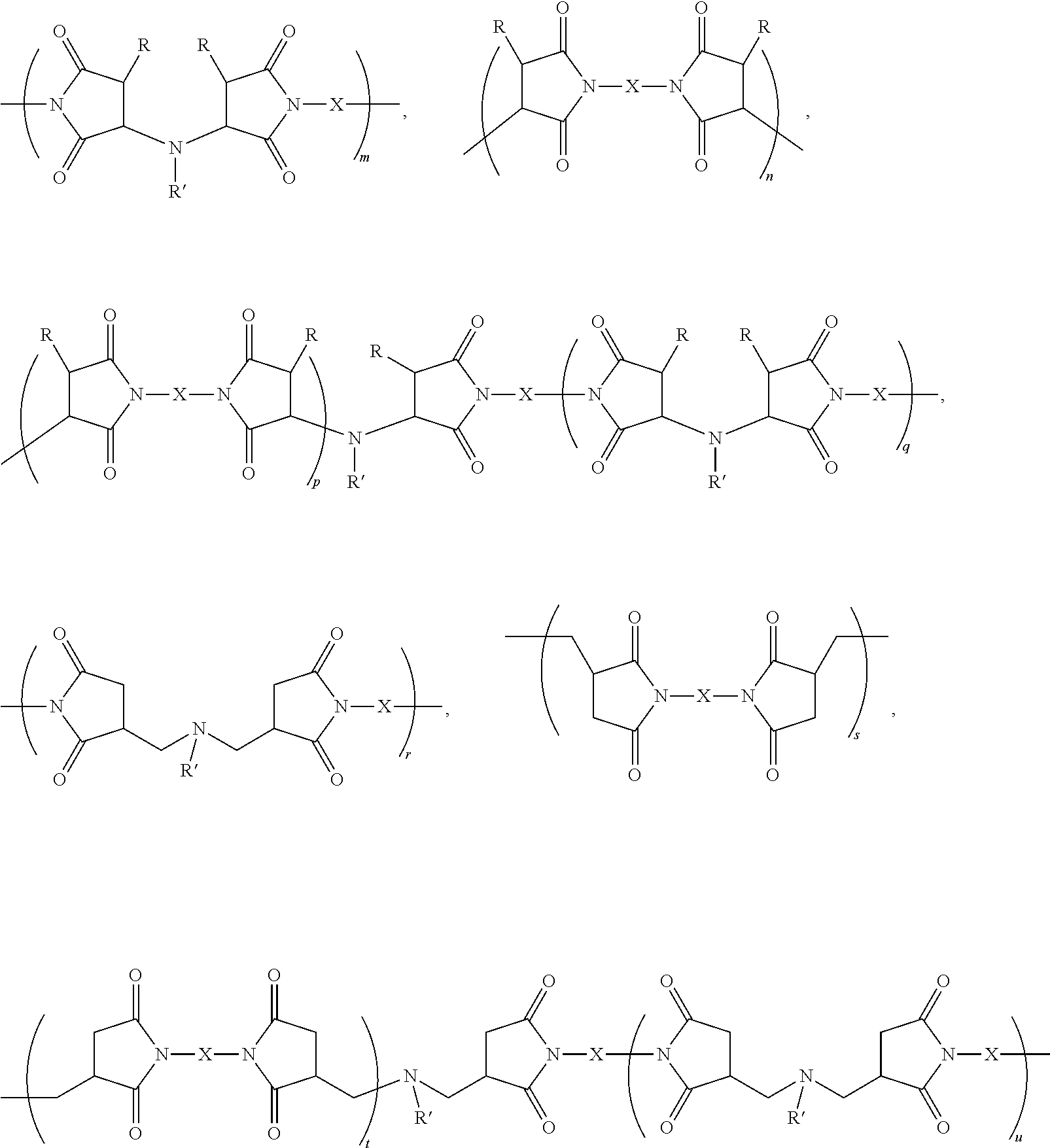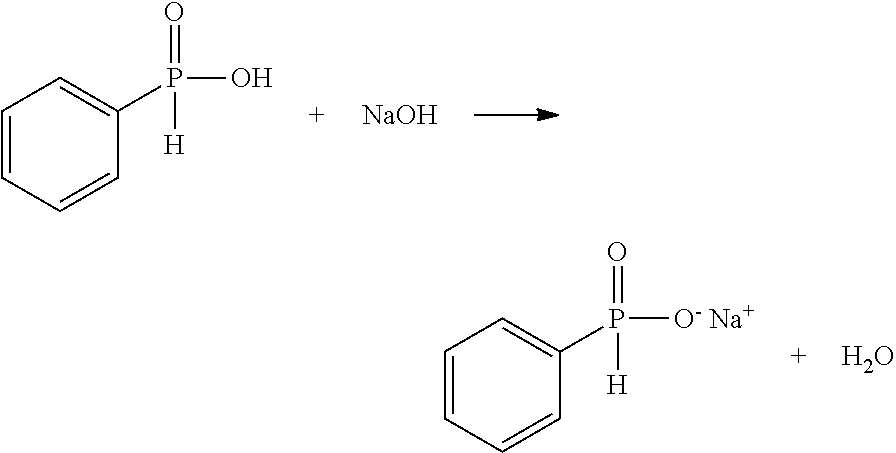Aliphatic polyimides from unsaturated monoanhydride or unsaturated diacid reacted with both monoamine and diamine
- Summary
- Abstract
- Description
- Claims
- Application Information
AI Technical Summary
Benefits of technology
Problems solved by technology
Method used
Image
Examples
preparation of examples 1-24
[0057]Table A shows the ingredients used in all Examples of this document, except the sodium phenyl phosphinate which was synthesized as follows:
[0058]14.21 grams of phenylphosphinic acid (0.10 mole) was dissolved in 50 mL of methanol at room temperature in a 250 mL single-neck round bottom flask along with a magnetic stirring bar. Then 4.00 grams of sodium hydroxide (0.10 mole) was added and dissolved. The reaction was observed to be exothermic. The solution was kept stirring at room temperature for one hour. The pH value of the final solution was tested by a piece of pH test paper. The pH value was 7.
[0059]Most of the solvent was evaporated by keeping the flask in the hood for three days. Then a white solid precipitated out from the solution. The white solid was vacuum dried at 60° C. overnight to remove any residual solvent or moisture. The final material was a white solid of 11.87 grams.
TABLE AChemical NameFormCAS NumberVendorStructurecitraconic anhydrideliquid616-02-4Sigma Aldr...
examples 1-5
First Method, First Embodiment, First Sequence
[0060]Below is the reaction scheme for Examples 1-5.
[0061]wherein m is greater than about 20 and preferably greater than about 150, wherein n is greater than about 20 and preferably greater than about 150, wherein p+q are greater than about 20 and preferably greater than about 150, wherein x can be 1 to 1000, desirably about 5 to about 25, and preferably about 8 to about 14, and wherein y can be 1 to 100, desirably about 2 to about 35, and preferably about 2 to about 8 and X can be (CH2) where z is between 2 and 12, including the odd integers besides those shown in the Reaction Scheme above.
[0062]It is to be noted that for Comparative Example 2, an aromatic sulfone was used as X and is not included in the recitation of the claimed polyimides in Reaction Scheme for Examples 1-5.
example 1
Mixture of poly-4-N-butylamino-yl-4′-yl-((1,1′-decane-1,10-diyl)-bis-(3-methyl-pyrrolidine-2,5-dione)), poly-4,4′-yl-((1,1′-decane-1,10-diyl)-bis-(3-methyl-pyrrolidine-2,5-dione)) and poly-[4-N-butylamino-yl-4′-yl-((1,1′-decane-1,10-diyl)-bis-(3-methyl-pyrrolidine-2,5-dione))]-co-[4,4′-yl-((1,1′-decane-1,10-diyl)-bis-(3-methyl-pyrrolidine-2,5-dione))]
[0063]An intermediate was prepared as follows. First, 2.2416 g of commercially available citraconic anhydride (0.02 mole) was dissolved in 10 g methanol in a single-neck flask along with a magnetic stirring bar. The flask was cooled down in an ice bath with magnetic agitation. Then, 0.7314 g of commercially available n-butylamine (0.01 mole) was dissolved in 5 g of methanol and added slowly into the cooled citraconic anhydride solution with stirring. The solution was clear and the addition of n-butylamine required about two hours, and the ice bath conditions were maintained for another one hour after the addition to ensure the complete ...
PUM
| Property | Measurement | Unit |
|---|---|---|
| Temperature | aaaaa | aaaaa |
| Substance count | aaaaa | aaaaa |
| Substance count | aaaaa | aaaaa |
Abstract
Description
Claims
Application Information
 Login to View More
Login to View More - R&D
- Intellectual Property
- Life Sciences
- Materials
- Tech Scout
- Unparalleled Data Quality
- Higher Quality Content
- 60% Fewer Hallucinations
Browse by: Latest US Patents, China's latest patents, Technical Efficacy Thesaurus, Application Domain, Technology Topic, Popular Technical Reports.
© 2025 PatSnap. All rights reserved.Legal|Privacy policy|Modern Slavery Act Transparency Statement|Sitemap|About US| Contact US: help@patsnap.com



